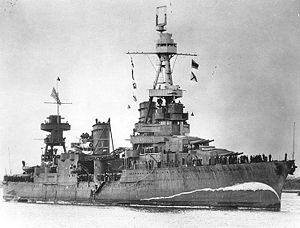- Northampton class cruiser
-

USS Northampton (CA-26)Class overview Name: Northampton class cruiser Operators:  United States Navy
United States NavyPreceded by: Pensacola-class cruiser Succeeded by: Portland-class cruiser (Heavy Cruiser)
Brooklyn-class cruiser (Light Cruiser)Completed: 6 Lost: 3 Retired: 3 Preserved: 0 General characteristics Type: Heavy Cruiser Displacement: 9,050 long tons (9,200 t) Length: 600 ft 3 in (182.96 m) Beam: 66 ft 1 in (20.14 m) Draft: 16 ft 4 in (4.98 m) Propulsion: 4-shaft Parsons turbines
8 White-Forster boilers
4 screws
107,000 hp (80 MW)Speed: 32.5 knots (60.2 km/h; 37.4 mph) Complement: 621
Officers: 55
Enlisted: 566Armament: - 9 × 8 in/55 caliber guns (3×triple turrets)
- 4 × 5 in/25 caliber guns
- 6 × 21-inch torpedo tubes
- 24 × 40 mm Bofors guns (4×quadruple turrets)
- 28 × 20 mm Oerlikon cannons
Armor: Belt 3" over machinery with 1" deck
3.75" side and 2" deck over magazines
barbettes 1.5"
gunhouses 2.5" face
2" roof
0.75" side and rearAircraft carried: 2 The Northampton class was a group of six heavy cruisers built for the U.S. Navy in the 1930s. The design of the ships was heavily influenced by the Washington Naval Treaty, which limited cruisers to a maximum of 10,000 tons displacement and a maximum main battery caliber of 8 inches (203 mm). The Northamptons were a reaction to the weight and cost of the immediately preceding Pensacola class, differing in several ways. The Pensacolas mounted a main battery of 10 8-inch (203 mm) guns in four turrets, a twin and superfiring triple fore and aft. In contrast, the Northamptons mounted 9 8-inch (203 mm) guns in three triple turrets, two forward and one aft, the layout followed in all subsequent U.S. heavy cruisers. Although armor was increased. the Northamptons turned out to be lighter than the Pensacolas, and nearly 1,000 tons below the treaty limitations. Freeboard was increased in the Northamptons by adopting a high forecastle, which was extended aft in the last three for use as flagships. These ships were also the first U.S. ships to adopt a hangar for aircraft, and bunks instead of hammocks. Their lighter than expected weight caused them to roll excessively, which necessitated the fitting of deep bilge keels. The immediately following Portland class was essentially a modified Northampton.
The Northamptons saw much action in World War II. Three (Northampton, Chicago, and Houston) were lost during the war. The other three were decommissioned soon after the end of the war, and scrapped in 1959-1961.
Ships in class:
- Northampton (CA-26)
- Chester (CA-27)
- Louisville (CA-28)
- Chicago (CA-29)
- Houston (CA-30)
- Augusta (CA-31)
External links
- Global Security.org - Northampton class cruiser
- Global Security.org - Northampton class cruiser specifications
Northampton-class cruiserNorthampton · Chester · Louisville · Chicago · Houston · Augusta
Preceded by: Pensacola class - Followed by: Portland class
List of cruisers of the United States Navy United States naval ship classes of World War IIAircraft carriers Light aircraft carriers Escort carriers Battleships Large cruisers Heavy cruisers - Pensacola
- Northampton
- Portland
- New Orleans
- WichitaS
- Baltimore
- Oregon CityC
- Des MoinesC
Light cruisers Destroyers Destroyer escorts Patrol frigates Minesweepers Submarines - S — Single ship of class
- C — Completed after the war
- X — Cancelled
Categories:- Cruiser classes
- Northampton class cruisers
- World War II cruisers of the United States
Wikimedia Foundation. 2010.
